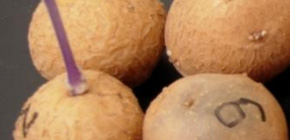
Potatoes not containing toxic compounds
Sprouting can also be controlled
A group of researchers led by Senior Research Scientist UMEMOTO Naoyuki and Principal Investigator SAITO Kazuki of the Metabolomics Research Group at the Center for Sustainable Resource Science, RIKEN; Professor MURANAKA Toshiya at Osaka University; and Associate Professor MIZUTANI Masaharu at Kobe University, identified Potato Glycoalkaloid Biosynthesis1 (PGA1) and PGA2. These two genes are related to biosynthesis of steroidal glycoalkaloids (SGA) such as solanine, a toxic substance included in potatoes. This group also found the possibility that inhibition of expression of these two genes will prevent SGA production and control sprouting of potatoes.
Sprouts and green tubers accumulate especially high levels of SGAs. Low levels of SGAs give potatoes a bitter taste, but higher levels of SGAs cause food poisoning , so keeping SGA levels low is important and essential in potato breeding.
For several months after being harvested, potato tubers undergo a period of dormancy with a temporary suspension of sprouting and visible growth. Sprouting starts after the dormancy period ends, so potatoes cannot be stored for longer than a year. Therefore, controlling sprouting is a great challenge for potato processors who are engaged in this business throughout a year.
SGAs are cholesterol-derived molecules, but the mechanism of SGA production was not known. This joint group examined genes that were expressed in buds and flowers, where SGA highly accumulated, and found PGA1 and PGA2. This group also clarified that PGA2 encoded 22 hydroxylase, which converts cholesterol into 22-hydroxycholesterol, and PGA1 encoded 26-hydroxylase, which converts 22-hydroxycholesterol into 22, 26-dihydroxycholesterol.
The amount of SGA in potatoes harvested from genetically engineered plants, in which expression of PGA1 and PGA2 was suppressed, was significantly reduced compared with those harvested from not-genetically engineered potatoes for both cases in which PGA1 was suppressed and cases in which PGA2 was suppressed. Furthermore, contrary to expectations, genetically engineered potatoes didn’t sprout even after the cessation of the dormancy period. After being planted in soil, they started sprouting.
This group's research results show that it is possible to breed potatoes that are non-toxic and that sprouting is controllable by suppressing expression of PGA1 and PGA2 or by destroying genes through genome editing techniques.
Abstract
α-Solanine and α-chaconine, steroidal glycoalkaloids (SGAs) found in potato (Solanum tuberosum), are among the best-known secondary metabolites in food crops. At low concentrations in potato tubers, SGAs are distasteful; however, at high concentrations, SGAs are harmful to humans and animals. Here, we show that POTATO GLYCOALKALOID BIOSYNTHESIS1 (PGA1) and PGA2, two genes that encode cytochrome P450 monooxygenases (CYP72A208 and CYP72A188), are involved in the SGA biosynthetic pathway, respectively. The knockdown plants of either PGA1 or PGA2 contained very little SGA , yet vegetative growth and tuber production were not affected. Analyzing metabolites that accumulated in the plants and produced by in vitro enzyme assays revealed that PGA1 and PGA2 catalyzed the 26- and 22-hydroxylation steps, respectively, in the SGA biosynthetic pathway. The PGA-knockdown plants had two unique phenotypic characteristics: The plants were sterile and tubers of these knockdown plants did not sprout during storage. Functional analyses of PGA1 and PGA2 have provided clues for controlling both potato glycoalkaloid biosynthesis and tuber sprouting, two traits that can significantly impact potato breeding and the industry.
Figure 1
Figure 2
Figure 3
To learn more about this research, please view the full research report entitled “ Two Cytochrome P450 Monooxygenases Catalyze Early Hydroxylation Steps in the Potato Steroid Glycoalkaloid Biosynthetic Pathway ” at this page of the Plant Physiology website.
Related link
